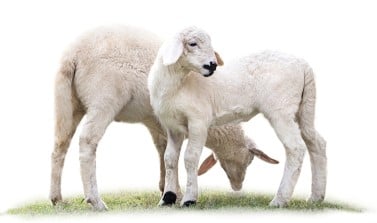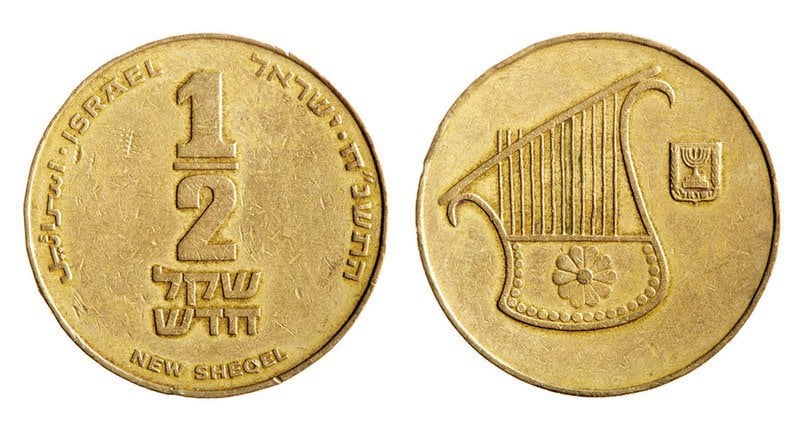And he shall take the two he goats, and place them before the Lord at the entrance to the Tent of Meeting. And Aaron shall place lots upon the two he goats: one lot “For the Lord,” and the other lot, “For Azazel.” (Leviticus 16:7-8)
In the last Torah portion, Metzorah, we learned about two entangled birds. This week, we learn about two entangled goats. I don’t know if these goats studied quantum mechanics, but they can sure teach us a thing or two about quantum entanglement.
Entanglement is one of the mysteries of quantum mechanics. On a macro level, entanglement is easy to understand. Imagine a coin sawn into two halves along the plane parallel to the face of the coin. One half has only heads and the other half has only tails. Let’s send each of these halves to two people, Shimon and Reuven. If Shimon gets the half with the heads, he knows immediately that Reuven got the half with the tails, even if Reuven didn’t yet open the envelope. In other words, the states (heads or tails) of two halves always remain correlated—if one is heads, the other is necessarily tails. In the parlance of quantum mechanics, these two halves are said to be entangled.
(As an aside, although I have never seen anyone actually splitting a coin into two halves, we do have in Jewish tradition a similar, but real, example. When animal skin is prepared for ritual purposes (e.g., to write a tefilin or a mezuzah) the whole skin (cutis or full hide called in Heb. gevil), is split into two layers: epidermis (the outer level next to the animal’s hair, klaf, used to write tefilin) and dermis (the inner layer next to the animal’s flesh, dukhsustus, used to write mezuzot). The two halves of the hide are entangled—if one is klaf, the other is necessarily dukhsustus.)
On a macro level, the entanglement does not present any problem—the information about each of the two halves in our examples is always known in principle. On a micro level, things are more complicated.
Let us consider two electrons that collided and then separated, each going off in a different direction. Because these two electrons have collided, i.e., they interacted with each other, they became entangled, they are described by the same wavefunction and share the same state no matter how far from each other—the law of conservation demands that if the spin of the first electron is pointing up, the spin of the other electron is pointing down. However, before we measure the spin, each of the electrons with equal probability can be found in any of two possibles states: SPIN UP or SPIN DOWN. That means that each of them is in a state of superposition ½ SPIN UP + ½ SPIN DOWN. Suppose we measure the spin of one electron and find it to be in a state SPIN UP. The spin of the other electron immediately becomes fixed in the state SPIN DOWN. In other words, the collapse of the wavefunction of the first electron instantaneously causes the collapse of the wavefunction of the second electron. The precise mechanism of how it happens is unclear. The strangest aspect of it all is that information about the state of the first particle seems to reach the second particle faster than the speed of light—in fact, instantaneously. This is what Einstein called “spooky action at a distance.”
In reality, there is no signal that is transmitted between two entangled particles. So entanglement does not violate the theory of relativity. Two entangled particles are described by a single wave function (or a single state vector)—thus they are always correlated. Learning some information about one particle automaticaly reveals the information about its entangled partner.
Back to our muttons … or goats for that matter. Once the two goats are designated as sacrificial goats, they become entangled. If one of them dies, we don’t replace just the dead goat with a live goat, we must replace both goats. Similarly, if something happens to one of the goats (e.g., it develops a blemish—in Heb. a “mum“), disqualifying it from being fit for sacrifice (korban), we don’t just replace the unfit goat, we replace the pair, because they are one unit, i.e., they are entangled.
A salient feature of electrons is that all electrons are exactly the same—their rest mass and charge are precisely the same (which caused Richard Feynman to wake up his Ph.D. advisor, John Archibald Wheeler in the middle of the night and exclaim, “John, did you realize—there is only one electron in the entire universe!”) Similarly, two sacrificial goats must be exactly the same—they must be of the same color, same height, and have same voice. Some authorities say, they must be twins. The parallel is uncanny…
Just like a pair of electrons, which must have the opposite spin, these two goats have opposite destinies—one is destined to G‑d and the other will be sent to Azazel. However, until the lot is cast, each goat (which must be identical like the two birds in the previous Torah portion, Metzorah) has exactly a 50% chance of getting the lucky draw of being offered to G‑d. We can say that each goat is in a state of superposition of two states: offered to G‑d or sent to Azazel: ½ to G‑d + ½ to Azazel. Once the lot is cast by the High Priest (Kohen Gadol) (in both Torah portions the role of a kohen seems to be to collapse the wave function), the wave function of the goat designated to G‑d is collapsed, which immediately collapses the wave function of the second goat, now necessarily designated to Azazel. This is entanglement in its full glory!


“The role of the Cohen seems to collapse the wave function “ ??
I thought the role of observer had been clearly established in quantum physics ?